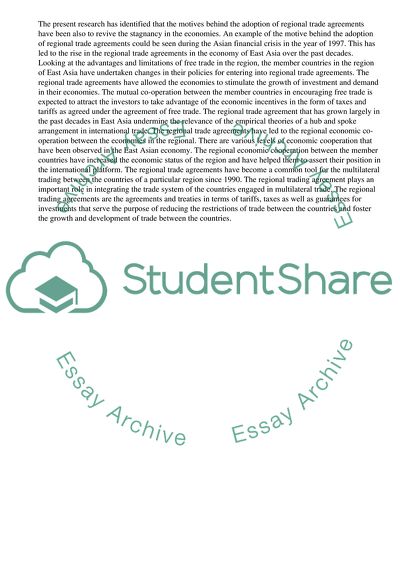Cite this document
(Regional Trading Agreements Essay Example | Topics and Well Written Essays - 2750 words - 1, n.d.)
Regional Trading Agreements Essay Example | Topics and Well Written Essays - 2750 words - 1. Retrieved from https://studentshare.org/business/1817283-east-asian-countries-have-witnessed-rapid-regional-economic-integration-in-the-past-decades-examine-the-rationale-for-various-types-of-regional-trading-agreements-rtas-in-the-region-and-evaluate-the-economic-impacts-of-these-rtas-on-east-asian-countrie
Regional Trading Agreements Essay Example | Topics and Well Written Essays - 2750 words - 1. Retrieved from https://studentshare.org/business/1817283-east-asian-countries-have-witnessed-rapid-regional-economic-integration-in-the-past-decades-examine-the-rationale-for-various-types-of-regional-trading-agreements-rtas-in-the-region-and-evaluate-the-economic-impacts-of-these-rtas-on-east-asian-countrie
(Regional Trading Agreements Essay Example | Topics and Well Written Essays - 2750 Words - 1)
Regional Trading Agreements Essay Example | Topics and Well Written Essays - 2750 Words - 1. https://studentshare.org/business/1817283-east-asian-countries-have-witnessed-rapid-regional-economic-integration-in-the-past-decades-examine-the-rationale-for-various-types-of-regional-trading-agreements-rtas-in-the-region-and-evaluate-the-economic-impacts-of-these-rtas-on-east-asian-countrie.
Regional Trading Agreements Essay Example | Topics and Well Written Essays - 2750 Words - 1. https://studentshare.org/business/1817283-east-asian-countries-have-witnessed-rapid-regional-economic-integration-in-the-past-decades-examine-the-rationale-for-various-types-of-regional-trading-agreements-rtas-in-the-region-and-evaluate-the-economic-impacts-of-these-rtas-on-east-asian-countrie.
“Regional Trading Agreements Essay Example | Topics and Well Written Essays - 2750 Words - 1”, n.d. https://studentshare.org/business/1817283-east-asian-countries-have-witnessed-rapid-regional-economic-integration-in-the-past-decades-examine-the-rationale-for-various-types-of-regional-trading-agreements-rtas-in-the-region-and-evaluate-the-economic-impacts-of-these-rtas-on-east-asian-countrie.


